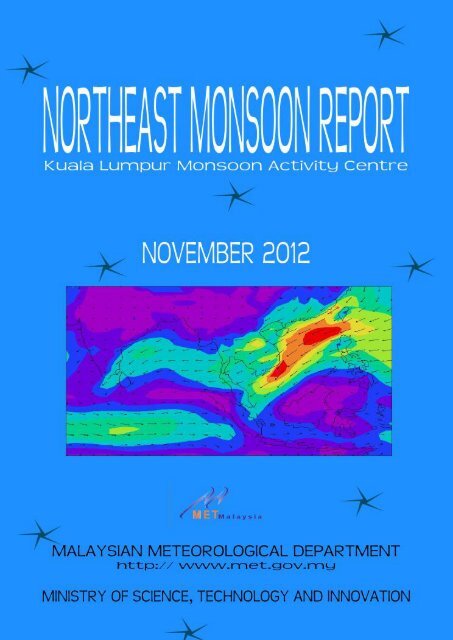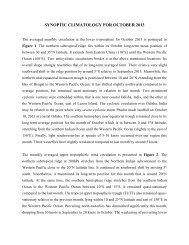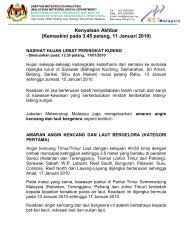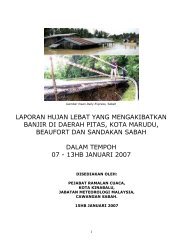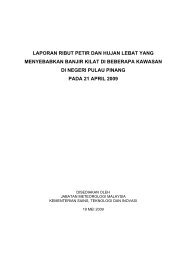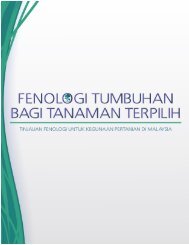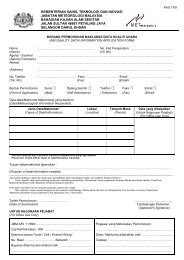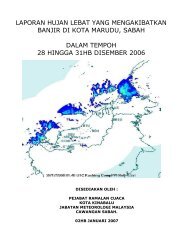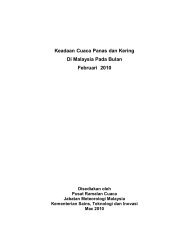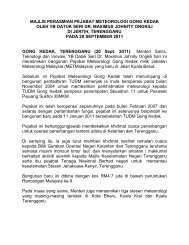Kuala Lumpur Monsoon Activity Centre November 2012
Kuala Lumpur Monsoon Activity Centre November 2012
Kuala Lumpur Monsoon Activity Centre November 2012
- No tags were found...
You also want an ePaper? Increase the reach of your titles
YUMPU automatically turns print PDFs into web optimized ePapers that Google loves.
IntroductionThe transition period from summer to winter season in the Northern Hemisphere takesplace during the period of September to October. During the Austral Winter season,mean sea level pressure increases over the Australian land mass, that results broadsoutheasterly wind flow from Southern Hemisphere towards the equator. The flow thenbecomes southwesterly to westerly after leaving the equatorial region and convergetowards the monsoon trough over the Asian land mass. Meanwhile, from Septemberonwards, the Asian land mass begins to cool and this results in the surface pressure torise over the continent and an equatorward shift of the monsoon trough. The southwardmovement of the trough is accompanied by the increasing influence of low-levelnortheasterly flow covering most of eastern China and Indochina.Since July till October <strong>2012</strong>, ENSO-neutral conditions continued despite the seasurfacetemperature (SST) anomalies remaining warmer-than-average across the centraland east-central equatorial Pacific Ocean during the period. Many aspects of thetropical atmosphere were inconsistent with El Niño conditions such as low-level tradewinds were near average along the equator and the pattern of tropical convection fromIndonesia to the central equatorial Pacific were too far west. However, there areongoing signs of a possibly imminent transition towards El Niño in the atmosphere aswell as the ocean.From July to October <strong>2012</strong>, 17 tropical cyclones occurred in the western North PacificOcean and South China Sea. Most tropical cyclones made landfall over East Asia suchas Taiwan, China, Japan or Korea except Tropical Storm Gaemi which made landfallover Southern Vietnam. This TS caused rough seas, strong winds and heavy rains overthat Vietnam provinces along the TS path. The remnants of this TS also brought heavyrains to Thailand. In Southeast Asia, Philippines and Vietnam were most vulnerablecompared to other countries because of tropical cyclone frequency and intensity.Although TS of typhoon category didn't make direct land fall over these countries, itsproximity brought heavy rains and high winds and caused severe flooding andlandslides.
1. Weather Conditions From July To October <strong>2012</strong>The 925-hPa mean wind analysis (Figure 1), from July to August <strong>2012</strong> shows thesouthwesterly flows prevailing over the Andaman Sea converging over South ChinaSea. The westerly winds extending over Philippines to Western Pacific Ocean inAugust compared to July. Since this period is the active tropical cyclones season in thewestern North Pacific Ocean, strong westerly flows extends from the Andaman Sea toPhilippines particularly in August. However, the strong southwesterly to westerly flowweakened as easterly trade winds from the Western Pacific Ocean started to penetrate inSeptember and becoming prominent in October. In October, light and variable windsare dominant over most of the region including Malaysia, Southern Philippines andparts of the Indian sub-continental signaling the arrival of the northeast monsoon inthis region.JULAUGSEPOCTFigure 1: 925-hPa Mean Wind Analysis (ms -1 ) from July to October <strong>2012</strong>
The times series of 850-hPa mean zonal wind averaged between 10˚N - 30˚N from 1July until 31 October <strong>2012</strong> (Figure 2) shows a significant change in the wind patternover the region. The westerly winds over the Indian sub-continental graduallystrengthened in mid July till end of August and diminished in September. Meanwhileeasterly flow persisted over the Western Pacific Ocean throughout the period and beginto extend over the Southeast Asia region in mid-October signifying the withdrawal ofsouthwest monsoon and the transition to the northeast monsoon is underway.Figure 2: Times Series of Mean Zonal Wind (ms -1 ) Averaged between10˚N - 30˚N at 850hPa for Jul-Oct <strong>2012</strong>2. Outgoing Longwave Radiation (OLR)The time series of OLR anomalies averaged between Equator and 10˚N and 10˚N to20˚N from 1 September to 31 October <strong>2012</strong> are shown in Figure 3. In both these belts,westward propagating easterly waves is very prominent. Closer to the equator westwardpropagation of convective system is more pronounced in the western Pacific. The phasespeed of propagation of the convective system is about 4 to 5 degrees longitude per dayand period of 10 to 15 days. In the belt between 10˚N to 20˚N westward propagatingwaves are very prominent in September and the first half of October with phase speed
of 3 to 4 degrees longitude per day and the convective system moving from the WesternPacific Ocean and into the South China Sea and Southeast Asian region.(a)(b)JULFigure 3: Times Series of OLR Anomalies (Wm -2 ) Averaged between Equator - 10˚N(left panel) and 10˚N - 20˚N (right panel) for September - October <strong>2012</strong>AUGSEPOCTFigure 4: Distribution of OLR Anomalies (Wm -2 ) from July to October <strong>2012</strong>
The monthly distribution of OLR anomalies as shown in Figure 4, shows that in July,enhanced convection over most of Southeast Asian countries especially Philippines,South China Sea and Ambon, Indonesia. Convective activity was less intense in Augustin the Indochina region, Southern Philippines and most parts of Indonesia. Wetter-thannormalconditions was observed over most of the Southeast Asian region exceptIndonesia in September. In October, most of the region experienced drier-than normalcondition except Borneo Island and adjacent South China Sea, eastern Indian Oceanand western North Pacific Ocean. The Indonesian Archipelago and mainland SoutheastAsia were drier than normal.3. Weather Outlook for December <strong>2012</strong> to February 2013Based on rainfall anomaly forecast (Figure 5) for December <strong>2012</strong> to February 2013generated from ECMWF and CFS seasonal forecast products, normal rainfall isexpected over Southeast Asia Region except central areas of southeastern of Thailand,east coast of Peninsular Malaysia, northeast of Mindanao Island and north of PapuaNew Guinea are expected to receive slightly above normal rainfall.Figure 5: December <strong>2012</strong> - February 2013 Rainfall Anomaly (%) Forecast


